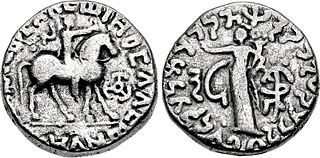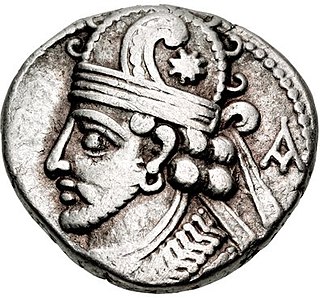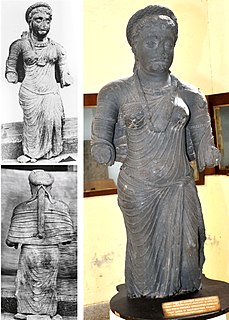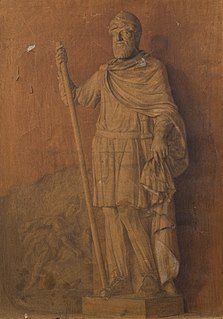 W
WAbdagases I was an Indo-Parthian king, who ruled Gandhara and possibly roughly over the Indus region from c. 46 to 60. He was a nephew and successor of Gondophares, who had laid foundations to the Indo-Parthians after revolting against his Arsacid overlords in c. 19. Abdagases was succeeded by Ortaghnes or Pacores.
 W
WArtabanus II, incorrectly known in older scholarship as Artabanus III, was King of Kings of the Parthian Empire from 12 to 38/41, with a one-year interruption. He was the nephew and successor of Vonones I. His father was a Dahae prince, whilst his mother was a daughter of the Parthian King of Kings Phraates IV
 W
WArtabanus III, incorrectly known in older scholarship as Artabanus IV, was a Parthian prince who competed against his brother Pacorus II for the Parthian crown from 79/80 to 81. Artabanus III's claim to the throne seems to have little support in the Parthian Empire, with the exception of Babylonia. Artabanus III's most notable action was to give refuge to a Pseudo-Nero named Terentius Maximus. Artabanus III initially agreed to lend military aid to Terentius Maximus to capture Rome, until he found about the real identity of the impostor. Coin mints of Artabanus III disappear after 81, which suggests that Pacorus II had defeated him.
 W
WArtav was a Khwarazmian king who ruled the Khwarazm region of Central Asia in the second half of the 2nd-century. He was the second king of an unnamed kingdom in Khwarazm, founded by his predecessor, whose name is unknown. Artav, during his reign, started the construction of the city of Toprak-Kala, which became his capital.
 W
WArtavasdes IV of Armenia; also known as Artavasdes II of Atropatene; Artavasdes II of Media Atropatene and Armenia Major; Artavasdes II and Artavasdes was an Iranian prince who served as King of Media Atropatene. During his reign of Media Atropatene, Artavasdes also served as a Roman Client King of Armenia Major.
 W
WAspavarma was an Indo-Scythian ruler of the clan of the Apraca, who ruled from around 15 to 45 CE. He ruled in the Bajaur area of modern Pakistan, and is considered one of the Apraca rulers. He is essentially known through his coins and a few inscription.
 W
WBhadayasa was a minor Indo-Scythian ruler in the areas of Eastern Punjab and Mathura in India, during the 1st century CE. He is considered one of the Northern Satraps.
 W
WGondophares III Gudana, or Gadana, previously called Orthagnes, was an Indo-Parthian king. He may have ruled circa 20–30 CE. He was one of the successors of Gondophares, together with Abdagases, Sases, Gondophares II, Sarpedones, and Pacores. He may have ruled from Arachosia to Eastern Punjab.
 W
WGondophares I was the founder of the Indo-Parthian Kingdom and its most prominent king, ruling from 19 to 46. A member of the House of Suren, he belonged to a line of local princes who had governed the Parthian province of Drangiana since its disruption by the Indo-Scythians in c. 129 BC. During his reign, his kingdom became independent from Parthian authority and was transformed into an empire, which encompassed Drangiana, Arachosia, and Gandhara. He is generally known from the dubious Acts of Thomas, the Takht-i-Bahi inscription, and coin-mints in silver and copper.
 W
WGotarzes II was king of the Parthian Empire from 40 to 51. He was an adopted son of Artabanus II. When his father died in 40, his brother Vardanes I was to succeed to the throne. However, the throne was seized by Gotarzes II. Gotarzes II eventually was able to gain control of most of Parthia forcing Vardanes to flee to Bactria. With the death of Vardanes in c. 46, Gotarzes II ruled the Parthian Empire until his death. Gotarzes II was succeeded by his uncle Vonones II.
 W
WHagamasha was an Indo-Scythian Northern Satrap. In central India, the Indo-Scythians are thought to have conquered the area of Mathura over Indian kings around 60 BCE, thus founding the Northern Satraps. Some of their first satraps were Hagamasha and Hagana, who were in turn followed by Rajuvula, but according to some authors, Rajuvula may have been first.
 W
WHagana was an Indo-Scythian Northern Satrap.
 W
WKharahostes or Kharaostasa was an Indo-Scythian ruler in the northern Indian subcontinent around 10 BCE – 10 CE. He is known from his coins, often in the name of Azes II, and possibly from an inscription on the Mathura lion capital, although another satrap Kharaostes has been discovered in Mathura.
 W
WMeherdates was a Parthian prince who competed against Gotarzes II for the Parthian crown from 49 to 51. A son of Vonones I, he was ultimately defeated and captured by Gotarzes II, who spared him, but had his ears mutilated, an act that disqualified him from inheriting the throne.
 W
WMujatria, previously read Hajatria, is the name of an Indo-Scythian ruler, the son of Kharahostes as mentioned on his coins.
 W
WOrodes I of Elymais was the ruler of Elymais in the late 1st-century. Unlike the previous rulers of the kingdom, he belonged to a cadet branch of the Arsacid dynasty. His reign thus marks the start of a second line of rulers that replaced the original Kamnaskirid line. While the Kamnaskirid rulers only used Greek legends on their coins, the Arsacid rulers of Elymais used both Greek and Aramaic. Orodes I was succeeded by his son Orodes II, known as Kamnaskires-Orodes.
 W
WOrodes II of Elymais, also known as Kamnaskires-Orodes, was the ruler of Elymais in the late 1st-century. He was the son and successor of Orodes I, and was himself succeeded by a certain Phraates.
 W
WOsroes I was a Parthian contender, who ruled the western portion of the Parthian Empire from 109 to 129, with a brief interruption from 116 to 117. For the whole of his reign he contended with the rival king Vologases III based in the eastern parts.
 W
WPacorus II was the King of Kings of the Parthian Empire from 78 to 110. He was the son and successor of Vologases I.
 W
WPakor I was king of Persis in the first half of the 1st century CE, a vassal state of the Parthian Empire. He is known to have adopted on his coins the same hairstyle used on the coins of the Parthian king Phraates III.
 W
WPhraates V, also known by the diminutive version of his name, Phraataces, was the King of Kings of the Parthian Empire from 2 BC to 4 AD. He was the younger son of Phraates IV and Musa, who ruled with him.
 W
WRajuvula was an Indo-Scythian Great Satrap (Mahakshatrapa), one of the "Northern Satraps" who ruled in the area of Mathura in the northern Indian Subcontinent in the years around 10 CE. The Mathura lion capital was consecrated under the reign of Rajuvula. In central India, the Indo-Scythians had conquered the area of Mathura from Indian kings around 60 BCE. Some of their satraps were Hagamasha and Hagana, who were in turn followed by Rajuvula.
 W
WSarpedones was an Indo-Parthian king. He was a lieutenant or kinsman of Gondophares, and ruled Sakastan, where he had coins minted with the title of King of Kings.
 W
WSases, also known as Gondophares IV Sases, (ruled for at least 26 years during the mid-1st century CE), was an Indo-Parthian king who ruled in northwestern parts of India in modern Pakistan. He is only known from coins.
 W
WSodasa was an Indo-Scythian Northern Satrap and ruler of Mathura during the later part of the 1st century BCE or the early part of 1st century CE. He was the son of Rajuvula, the Great Satrap of the region from Taxila to Mathura. He is mentioned in the Mathura lion capital.
 W
WTiridates I was King of Armenia beginning in 53 and the founder of the Arsacid dynasty of Armenia. The dates of his birth and death are unknown. His early reign was marked by a brief interruption towards the end of the year 54 and a much longer one from 58 to 63. In an agreement to resolve the Roman–Parthian conflict in and over Armenia, Tiridates I was crowned king of Armenia by the Roman emperor Nero in 66; in the future, the king of Armenia was to be a Parthian prince, but his appointment required approval from the Romans. Even though this made Armenia a client kingdom, various contemporary Roman sources thought that Nero had de facto ceded Armenia to the Parthian Empire.
 W
WVardanes I was a king of the Parthian Empire from 40 to 46 AD. He was the heir apparent of his father Artabanus II, but had to continually fight against his brother Gotarzes II, a rival claimant to the throne. Vardanes' short reign ended when he was assassinated while hunting at the instigation of a party of Parthian nobles.
 W
WVardanes II was the son of Vologases I and briefly ruler of parts of the Parthian Empire. In ancient records he only appears in Tacitus. Otherwise he is only known from coins that are dated between 55 to 58 CE. He rebelled against his father from about 55 to 58 CE and must have occupied Ecbatana, since he issued coins from the mint there, bearing the likeness of a young beardless king wearing a diadem with five pendants. Nothing more about him is known.
 W
WVologases I was the King of Kings of the Parthian Empire from 51 to 78. He was the son and successor of Vonones II. He was succeeded by his younger son Pacorus II, who continued his policies.
 W
WVologases II was a Parthian prince who competed against his brother Pacorus II for the Parthian crown from 78, until his defeat in 80.
 W
WVonones I was an Arsacid prince, who ruled as King of Kings of Parthian Empire from 8 to 12, and then subsequently as king of Armenia from 12 to 18. He was the eldest son of Phraates IV and was sent to Rome as a hostage in 10/9 BC in order to prevent conflict over the succession of Phraates IV's youngest son, Phraataces.
 W
WVonones II was a Parthian prince who ruled as king of Media Atropatene and briefly as king of the Parthian Empire.
 W
WZeionises was an Indo-Scythian satrap of the area of southern Chach (Kashmir) for king Azes II.